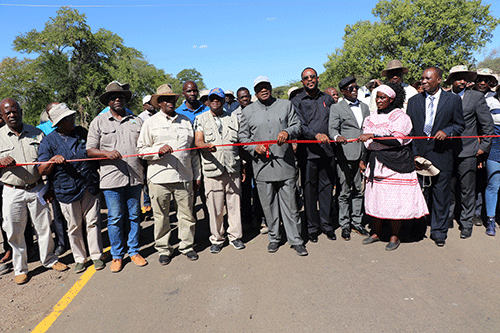IMPALILA – For years, driving around Impalila Island has been a daunting challenge due to its rocky surface, which becomes muddy and sticky, particularly during the rainy season.
This will be something of the past after Works minister and Deputy Prime Minister John Mutorwa last Thursday officiated the opening of the low-volume seal road that was constructed at Impalila Island in the Zambezi region.
The N$151 million 25-kilometre project included the construction of minor access roads to public institutions on the island, among them the secondary school, the clinic, the Office of the President, the Navy base, and the immigration office.
In his remarks, Mutorwa stated that the completed project has a plethora of benefits.
“The island’s rocky terrain with soft clay soil created severe mobility and accessibility challenges to essential services and government offices. Now that the construction of the road is complete, I am sure motorists and the community on the island have experienced a reduction in vehicle operating and transport costs,” he stated.
He added that it will also promote trade and tourism, and significantly improve the lives of the people of Impalila Island.
“Completing these roads highlights our government’s commitment to improving transportation networks countrywide. In a nutshell, we recognise the importance of accessible and reliable roads in facilitating economic growth, fostering social cohesion and enhancing our citizens’ overall quality of life,” emphasised Mutorwa.
The road was constructed by Nexus Civils, the company that also constructed the Namalubi-Isize-Luhonono road, now known as Brenden Simbwaye Road.
Impalila Island is situated at the far-eastern point of the former Caprivi strip, now known as the Zambezi region.
It borders three countries, namely Zambia, Botswana and Zimbabwe, and is completely surrounded by three rivers: Zambezi to the north, Kasaya to the west and Chobe to the south.
The island is only accessible by boat from Kasika to Impalila harbour during the dry season. In addition to that, accessibility to the island can also be undertaken via District Road 3524 (Nakabolelwa-Mbalasinte-Kasika), which is approximately 35 kilometres long, and is an earth track through the flood plains.
Meanwhile, Roads Authority board member Hellen Amupolo announced that plans are at an advanced stage to upgrade District Road 3524 to low-volume standards.
“The detail design is done. Funds have been allocated to procure a consultant for site supervision and contract administration, as well as a contractor in this very financial year. The project will be implemented in phases, and will be funded by the government of Namibia. A total budget of N$35 million has been allocated for this project,” added Amupolo.
*Aaron Mushaukwa is an information officer in the MICT in the Zambezi region.


